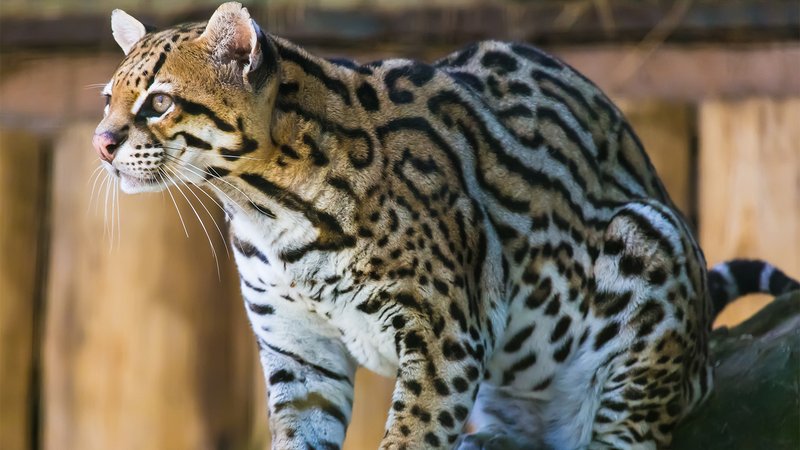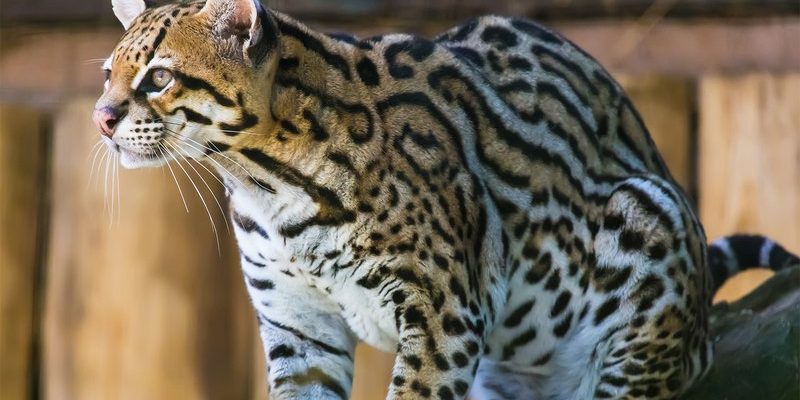
Now, here’s the thing: While the ocelot stands out on its own, many other creatures have similar features or behaviors. Some may look alike at first glance but possess unique traits that set them apart. This is kind of like when you see a friend wear the same shirt as someone else at a party—you might do a double-take, but then you notice the subtle differences in style and how they carry it. So, let’s jump in and explore these fascinating animals together!
1. Margay
The margay is often mistaken for the ocelot due to its similar size and striking coat pattern. These little felines are about the same size as house cats but are built for agility. They have longer legs and a unique ability to climb trees with ease. You might find them lounging on a branch, waiting for their next meal to scurry by.
A distinguishing feature is the margay’s larger eyes, which help them see better in low light. If you ever spot one, you’ll see that its coat has smaller, more intricate spots compared to the ocelot. And just to add more to their charm, margays can mimic the calls of other animals, making them quite the vocal critters in the wild.
2. Oncilla
Next up is the oncilla, another small cat that shares some similarities with the ocelot. The oncilla is slightly smaller than the ocelot and flaunts a similar coat with darker spots and stripes. While both cats share a penchant for stealth, the oncilla’s petite size means it often targets smaller prey.
To tell them apart, look closely at the patterns on their fur. The oncilla’s markings tend to be more linear and have a lighter background color. Plus, they have unique markings on their face that make them undeniably adorable. Picture a tiny, fluffy version of an ocelot, and you’ll get the gist!
3. Andean Mountain Cat
The Andean mountain cat is another lesser-known feline that resembles the ocelot in size but diverges greatly in habitat. This cat roams the rugged terrain of the Andes mountains in South America. Unlike the ocelot, which prefers tropical forests, the Andean mountain cat has adapted to a completely different lifestyle.
One way to distinguish it is by its distinctive greyish coat, which helps it blend into the rocky surroundings. Plus, it has a more robust build with shorter legs. If you’re ever trekking through the Andes, keep an eye out for this elusive beauty!
4. Jungle Cat
The jungle cat is another intriguing feline that can confuse those familiar with the ocelot. These cats are larger than ocelots and sport a more uniform coat, usually ranging from reddish-brown to light grey. Found in a variety of wetland habitats, jungle cats are excellent swimmers and can often be seen near water sources.
The most significant difference lies in their size and face shape. Jungle cats have longer limbs and a more elongated face with distinctive ear tufts. This gives them a regal look, almost like they are the royalty of the wetlands!
5. European Wildcat
Ah, the European wildcat—the rugged cousin of domestic cats. These felines have a shaggy appearance, with stripes on their fur that resemble the ocelot’s markings. While ocelots are found in Central and South America, European wildcats roam the forests and grasslands of Europe.
To tell them apart, you’ll want to pay attention to the tail. The European wildcat has a bushy tail with a black tip and a more robust body structure. Also, their fur is a bit coarser, contributing to that wild look. Imagine a scruffy cat that hasn’t been groomed in a while, and you’ll get the idea!
6. Serval
The serval is a striking cat with long legs and enormous ears. While they differ in appearance, servals and ocelots are both adept hunters. Servals thrive in African grasslands, where they can spot prey from a mile away. Their coat features black spots and stripes, but the markings are larger and more scattered compared to the ocelot’s.
The biggest giveaway is their size and those oversized ears, which help them hear even the tiniest movements in the grass. When you picture a serval, think of a tall, elegant cat that looks like it belongs on a fashion runway.
7. Fishing Cat
The fishing cat is a unique member of the feline family that primarily resides in wetlands and marshes. As the name suggests, these cats are experts at catching fish! Their larger size, somewhat flat face, and webbed feet make them remarkably different from ocelots.
When comparing them, you’ll notice that fishing cats have a more robust, muscular build, and their coat has more of a spotted pattern that resembles the ocelot but is often more muted in color. They’re fascinating to watch as they wade through water, using their paws to swipe at unsuspecting fish.
8. African Golden Cat
The African golden cat looks deceptively similar to the ocelot with its beautiful coat of reddish-brown fur. This elusive feline is primarily found in the rainforests of West and Central Africa. While both cats have similar habitats, the African golden cat is significantly shyer and less often spotted.
To identify them, look for the golden hue that gives this cat its name, along with a stockier build. They also have a distinctive face with a broader forehead. Think of it as the mystery-loving cousin of the ocelot that prefers the shadows.
9. Pallas’s Cat
Also known as the manul, Pallas’s cat is a fluffy little feline native to the grasslands of Central Asia. Unlike the ocelot, which has a sleek build, Pallas’s cat is rounder and fluffier, almost like a living cloud. While they do share some similarities in fur patterns, Pallas’s cat has a much broader face and shorter legs.
These cats are not just adorable; they’re also fierce hunters despite their cute appearance. When you think of Pallas’s cat, picture a playful fluffball that could easily be mistaken for a domestic cat at first glance.
10. Bobcat
Last but not least, let’s talk about the bobcat. While they are relatively larger than ocelots, they share similar markings and an elusive nature. Bobcats are widespread across North America and have a tufted tail similar in appearance to the ocelot’s but with its own unique characteristics.
The most notable difference is the bobcat’s distinctive bobbed tail, which sets it apart from ocelots. Plus, their ears have black tufts at the tips. Imagine a straightforward cat with a playful energy, and that’s the bobcat for you!
So, there you have it—ten animals that are similar to the ocelot, each with its own distinct personality and features. Whether it’s the charming margay with its agile skills or the elusive African golden cat, this diverse feline family has plenty to offer.
Next time you stumble upon an ocelot or its look-alikes, use these tips to spot the differences and appreciate the unique traits that each species brings. Honestly, while they might look similar at first, each cat plays its own vital role in the ecosystem, adding to the beauty and complexity of the wild world. Keep exploring, and you never know what fascinating discoveries await you!

